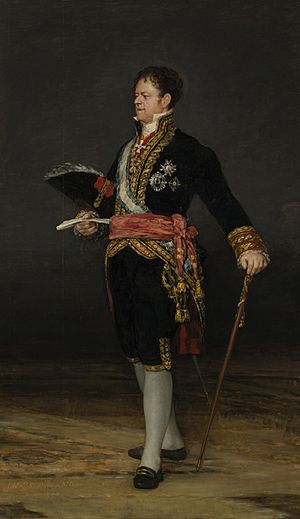José Miguel de Carvajal-Vargas, 2nd Duke of San Carlos facts for kids
Quick facts for kids
The Most Excellent
José Miguel de Carvajal-Vargas
The Duke of San Carlos
|
|
|---|---|

Portrait by Francisco Goya
|
|
| Prime Minister of Spain | |
| In office 4 May 1814 – 15 November 1814 |
|
| Monarch | Ferdinand VI |
| Preceded by | Jose Luyando |
| Succeeded by | Pedro Cevallos Guerra |
| Seat R of the Real Academia Española | |
| In office 10 November 1814 – 27 September 1828 |
|
| Preceded by | Ramón Cabrera y Rubio |
| Succeeded by | Javier de Burgos |
| Director of the Real Academia Española | |
| In office 10 November 1814 – 27 September 1828 |
|
| Preceded by | Ramón Cabrera y Rubio |
| Succeeded by | José Gabriel de Silva-Bazán |
| Personal details | |
| Born |
José Miguel de Carvajal-Vargas y Manrique de Lara Polanco
8 May 1771 Lima, Peru |
| Died | 27 September 1828 (aged 57) Paris, France |
| Nationality | Spanish |
José Miguel de Carvajal-Vargas y Manrique de Lara Polanco, 2nd Duke of San Carlos, was an important Spanish military leader and nobleman. He was born on May 8, 1771, in Lima, Peru. He passed away on September 27, 1828, in París, France. He was a close friend and trusted advisor to King Ferdinand VII of Spain. He even became the King's chief household manager and later his Prime Minister.
Contents
Early Life and Military Career
José Miguel was the son of Mariano Joaquín de Carvajal-Vargas, who was the 8th Count of Puerto. His mother was Maria Manrique de Lara Polanco y Carrillo. His grandfather, Fermín Francisco de Carvajal-Vargas, was born in Chile and was the 1st Duke of San Carlos.
José Miguel began his career in the Spanish Army while he was still in Peru. He moved to Spain in 1788. There, he quickly became a trusted friend of Ferdinand, who was then the Prince of Asturias (the heir to the throne).
Rising Through the Ranks
José Miguel de Carvajal-Vargas moved up quickly in the military.
- In 1793, he became a Colonel.
- By 1794, he was promoted to Brigadier.
- He became a Mariscal del Campo (Field Marshal) in 1795.
- Finally, in 1802, he reached the rank of Lieutenant General.
In 1807, he served as the Viceroy of Navarra for part of the year. A Viceroy was like a governor who ruled a region in the name of the King.
Political Influence and Royal Service
In 1808, José Miguel played a big role in the Tumult of Aranjuez. This event led to Manuel Godoy and King Charles IV of Spain losing their power. It also helped Ferdinand become the new King of Spain.
However, things changed when Napoleon forced King Ferdinand to give up his throne. Carvajal stayed loyal and followed Ferdinand into exile. In 1813, he helped write the Treaty of Valençay with France. This agreement made it possible for King Ferdinand VII to return to power.
Serving as Prime Minister
After King Fernando VII of Spain returned to power in 1814, José Miguel became the Secretary of State. This role was similar to being the Prime Minister of Spain. He held this important position from May to November 1814.
After his time as Prime Minister, he served Spain as an ambassador or envoy in several major European cities. These included:
- Saint-Petersburg
- Paris
- Vienna
- Lisbon
- London (from 1817 to 1820)
He also received many honors, such as being made a Knight in the Order of the Golden Fleece in 1814. He was also a Knight of the Military Order of Alcantara, along with other knighthoods from France, Naples, Prussia, Hungary, and Russia.
Other Important Roles
José Miguel de Carvajal-Vargas held several other significant positions:
- He was the director of the Royal Spanish Academy from 1814 to 1828. This academy is very important for the Spanish language.
- He was the King's chief household manager (Mayordomo mayor) three times.
- He became the Captain general of the Army from 1827 to 1828.
- He was also the director of the Banco de San Carlos, a bank founded in 1782.
Family Life
José Miguel de Carvajal-Vargas was married twice. His first wife was María del Rosario de Silva. They did not have any children together. After she passed away in 1802, he married María Eulalia de Queralt y Silva in 1803. She was the daughter of the Counts of Santa Coloma.
From his second marriage, he had six children. Two of his notable children were:
- José Fernando de Carvajal-Vargas y Queralt (1808-1872): He became the 3rd Duke of San Carlos and inherited his father's titles.
- Maria Luisa (1804-1843): She married Vicente Osorio de Moscoso in France in 1821.
Sources
- Real Academia de la Historia
- asasve
See also
 In Spanish: José Miguel de Carvajal y Manrique para niños
In Spanish: José Miguel de Carvajal y Manrique para niños

